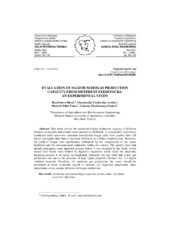Evaluation of Maximum Biogas Production Capacity from Different Feedstocks: An Experimental Study
Procena maksimalne proizvodnje biogasa iz različitih sirovina: eksperimentalna studija
| dc.contributor.author | Okosa, Ikechukwu | |
| dc.contributor.author | Chukwuka Austine, Onyenwoke | |
| dc.contributor.author | Ibiba Taiwo, Horsfall | |
| dc.contributor.author | Muofunanya Francis, Umunna | |
| dc.date.accessioned | 2020-04-07T18:56:48Z | |
| dc.date.available | 2020-04-07T18:56:48Z | |
| dc.identifier.uri | http://arhiva.nara.ac.rs/handle/123456789/2400 | |
| dc.description.abstract | This study reveals the maximum biogas production capacity of different biomass using plant and animal waste material as feedstock. A comparative experiment conducted under anaerobic condition showed that biogas yield from poultry litter (28 liters) was higher than that of rice husk (18 liters) in a 30day retention time. However, the yield of biogas was significantly influenced by the composition of the waste feedstock and the environmental conditions within the reactor. The poultry litter had already undergone some digestion process before it was excreted by the birds, which means their bonds were broken by digestive organisms which made the anaerobic digestion process to be easily accomplished. Similarly, the rice husk had a low gas production rate due to the presence of high lignin properties because rice is a lignin cellulose material. Therefore, for optimum gas production, the waste should be pretreated at lower temperate region to increase the digestion temperature since temperature exerts a major influence in biogas production. | sr |
| dc.description.abstract | Ova studija prikazuje najveći kapacitet proizvodnje biogasa od različitih biomasa, kada se koristi kao početna sirovina biljni i životinjski otpadni materijal. Uporedni eksperiment u anaerobnim uslovima pokazuje da je količina biogasa od živine (28 litara) veći od ljuski pirinča (18 litara) u roku trajanja ciklusa u reaktoru od 30 dana. Međutim, na prinos biogasa je značajno uticao sastav otpadne sirovine i uslovi životne sredine u reaktoru za gas. Prostirka za živinu već je bila podvrgnuta nekom procesu razgradnje pre nego što je živina (ptice) ostavila svoj deo, što omogućuje da se anaerobni proces lako izvrši. Slično tome, ljuska pirinča ima malu mogućnost proizvodnje gasa zbog prisustva visokih sadržaja celuloze (lignin. Zbog toga, za optimalnu proizvodnju gasa, otpad treba prethodno predtretirati u oblasti nižih temperatura da bi se posle povećala temperatura razgradnje, jer temperatura digestije u bioreaktoru ima veliki uticaj na proizvodnju biogasa. | sr |
| dc.subject | prediction | sr |
| dc.subject | maximum biogas capacity | sr |
| dc.subject | poultry litter | sr |
| dc.subject | rice husk | sr |
| dc.subject | anaerobic digestion | sr |
| dc.subject | predviđanje | sr |
| dc.subject | najveći kapacitet za gas | sr |
| dc.subject | ljuske pirinča | sr |
| dc.subject | anaerobno razlaganje | sr |
| dc.title | Evaluation of Maximum Biogas Production Capacity from Different Feedstocks: An Experimental Study | sr |
| dc.title.alternative | Procena maksimalne proizvodnje biogasa iz različitih sirovina: eksperimentalna studija | sr |
Files in this item
This item appears in the following Collection(s)
-
Issue 2020-1.
www.jageng.agrif.bg.ac.rs/files/casopis/PT_01-2020.pdf



